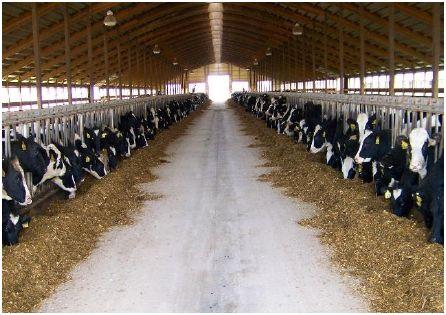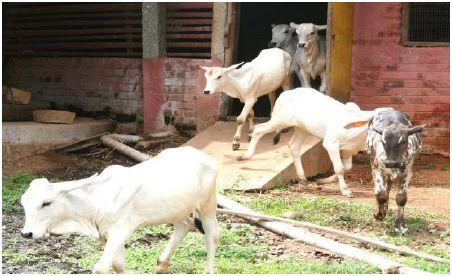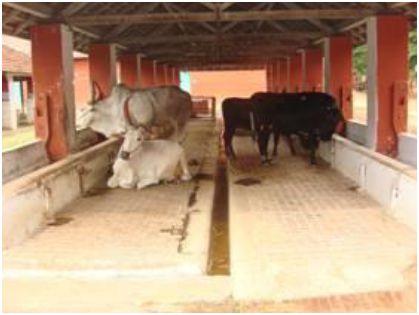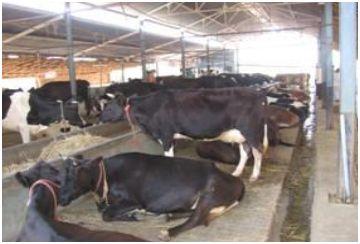Beef Cattle Facilities Rooming How Much Space Does One Cow Need in Feet
An efficient direction of cattle will be incomplete without a well-planned and adequate housing of cattle. Improper planning in the arrangement of fauna housing may result in additional labour charges and that curtail the profit of the owner. During erection of a firm for dairy cattle, intendance should be taken to provide comfortable accommodation for individual cattle. No less of import is the proper sanitation, durability and arrangements for the production of clean milk under convenient and economic weather condition, etc.
Location of dairy buildings
The points which should be considered before the erection of dairy buildings are as follows.
Topography and Drainage
- A dairy building should be at a higher meridian than the surrounding ground to offering a practiced slope for rainfall and drainage for the wastes of the dairy to avoid stagnation inside.
- A leveled area requires less site training and thus bottom cost of building.
- Depression lands and depressions and proximity to places of bad smell should be avoided.
Soil Type
- Fertile soil should be spared for cultivation.
- Foundation soils as far equally possible should not be too dehydrated or desiccated.
- Such a soil is susceptible to considerable swelling during rainy season and exhibit numerous cracks and fissures.
Exposure to the dominicus and protection from current of air
- A dairy building should exist located to a maximum exposure to the sun in the northward and minimum exposure to the lord's day in the s and protection from prevailing strong wind currents whether hot or cold.
- Buildings should be placed then that directly sunlight can accomplish the platforms, gutters and mangers in the cattle shed.
- Equally far as possible, the long axis of the dairy barns should be set in the northward-s direction to take the maximum benefit of the sun.
Accessibility
- Easy accessibility to the buildings is always desirable.
- Situation of a cattle shed past the side of the chief road preferably at a distance of about 100 meters should exist aimed at.
Immovability and attractiveness
- Information technology is always bonny when the buildings open up upwardly to a scenic view and add together to the grandeur of the scenery. Along with this, durability of the construction is patently an important benchmark in building dairy
Water supply
- Arable supply of fresh, clean and soft water should .be available at a cheap rate.
Surroundings
- Areas infested with wild animals and dacoits should be avoided.
- Narrow gates, high manger curbs, loose hinges, protruding nails, smooth finished flooring in the areas where the cows move and other such hazards should be eliminated.
Labour
- Honest, economic and regular supply of labour is available.
Marketing
- Dairy buildings should only exist in those areas from where the owner can sell his products profitably and regularly.
- He should be in a position to satisfy the needs of the farm within no fourth dimension and at reasonable price.
Electricity
- Electricity is the most important sanitary method of lighting a dairy.
- Since a modem dairy always handles electrical equipment's which are also economical, it is desirable to have an acceptable supply of electricity.
Facilities, Labour, Food
Cattle yards should exist and so constructed and situated in relation to feed storages, hay stacks, silo and manure pits as to affect the virtually efficient utilization of labour. Sufficient space per cow and well-arranged feeding mangers and resting are contributing not only to greater milk yield of cows and make the piece of work of the operator easier also minimizes feed expenses. The relative position of the feed stores should exist quite next to the cattle barn. Note : Worthy features of feed stores are given:
- Feed storages should be located at hand virtually the eye of the cow befouled.
- Milk-house should exist located almost at the center of the befouled.
- Centre cross-alley should be well designed with reference to feed storage, the stall area and the milk house.
Types of Housing
The almost widely prevalent practice in our country is to tie the cows with rope on a Katcha floor except some organized dairy farms belonging to government, co-operatives or military where proper housing facilities exist. It is quite easy to empathize that unless cattle are providing with skilful housing facilities, the animals will motion too far in or out of the continuing space, defecating all circular and even causing trampling and wasting of feed by stepping into the mangers. The animals will be exposed to extreme conditions conditions all leading to bad wellness and lower product. Dairy cattle may exist successfully housed under a broad diversity of conditions, ranging from close confinement to lilliputian restrictions except at milking time. However, two types of dairy barns are in general use at the nowadays fourth dimension.
- The loose housing barn in combination with some type of milking barn or parlor.
- The conventional dairy befouled.
Loose Housing System
- Loose housing may be divers as a system where animals are kept loose except milking and at the time of treatment. The system is most economical. Some features of loose housing organisation are every bit follows.
- Price of construction is significantly lower than conventional type.
- Information technology is possible to brand further expansion without change
- Facilitate piece of cake detection of animate being in rut.
- Animals feel costless and therefore, proves more than profitable with fifty-fifty minimum grazing
- Animals get optimum excise which is extremely important for better health product.
- Over all ameliorate management tin be rendered.
| Cattle Shed
|  Cattle Shed |
| Shed for calves
|  Shed for calves |
Conventional Dairy Befouled
- The conventional dairy barns are comparatively plush and are now becoming less popular 24-hour interval by day. However, by this organisation cattle are more protected from adverse climatic condition.
- The following barns are by and large needed for proper housing of different classes
Dairy Stock in the Subcontract
- Moo-cow houses or sheds
- Calving box
- Isolation box
- Sheds for young stocks
- Bull or bullock sheds
Cow Sheds
- Moo-cow sheds can be bundled in a unmarried row if the numbers of cows are pocket-size.
- Say less than ten or in a double row if the herd is a big one.
- Ordinarily, not more than 80 to 100 cows should be placed in one building.
- In double row housing, the stable should be so arranged that the cows face out (tails to tail organisation) or face in (head to head arrangement) as preferred.
| Advantages of tail to tail system
| Tail to tail organisation |
| Advantages of face to face up system
| Face to face system |
Floor
- The inside flooring of the befouled should exist of some impervious material which can be easily kept clean and dry out and is non slippery.
- Paving with bricks can also serve ones purpose. Grooved cement physical flooring is however amend.
- The surface of the cowshed should be laid with a slope of 1" to 1.25" from manger to excreta aqueduct. An overall floor space of 65 to 70 sq.feets. Per adult moo-cow should be satisfactory.
Walls
- The within of the walls should have a smooth hard· finish of cement, which volition not permit whatsoever lodgment of dust and wet.
- Comers should be circular.
- For plains, dwarf walls most four to 5 anxiety in summit and roofs supported by masonry work or iron pillars will be best or more suitable.
- The open up space in between supporting pillars will serve for light and air circulation.
Roof
- Roof of the barn may be of asbestos canvas or tiles.
- Corrugated iron sheets have the disadvantage of making extreme fluctuations in the within temperature of the barn in different seasons.
- However, atomic number 26 sheets with aluminum painted tops to reverberate sun rays and bottoms provided with wooden insulated ceilings tin can also achieve the objective.
- A height of 8 feet at the sides and 15 feet at the ridge will exist sufficient to give the necessary air space to the cows.
- An adult cow requires at least about 800 cubic feet of air space under tropical weather condition.
- To make ventilation more effective a continuous ridge ventilation is considered well-nigh desirable.
Manger
- Cement concrete continuous manger with removable partitions is the all-time from the point of view of immovability and cleanliness.
- A height of 1'-4" for a high front manger and half dozen" to 9" for a low forepart manger is considered sufficient. Low front mangers are more than comfortable for cattle just high front mangers prevent feed wastage.
- The acme at the back of the manger should be kept at 2'-six" to iii".
- An overall width of 2' to 2.5' is sufficient for a adept manger.
Alleys
- The central walk should have a width of five'-6' exclusive of gutters when cows face out, and 4'-5' when they confront in.
- The feed alley, in case of a face up out system should be four' wide, and the cardinal walk should show a gradient of 1" from the centre towards the two gutters running parallel to each other, thus forming a crown at the eye.
Manure Gutter
- The manure gutter should be wide plenty to concur all dung without getting blocked, and be easy to clean/ Suitable dimensions are 2" width with a cantankerous-fall of i" away from standing.
- The gutter should accept a gradient of ane" for every 10' length.
- This volition permit a gratis menstruation of liquid excreta.
Doors
- The doors of a single range cowshed should be 5" wide with a height of 7', and for double row shed the width should not be less than eight" to 9'.
- All doors of the barn should lie flat confronting the external wall when fully open.
Calving Boxes
- Allowing cows to calve in the milking cowshed is highly undesirable and objectionable.
- Information technology leads to in sanitary in milk production and spread of disease similar contagious abortion in the herd. Special accommodation in the form of loose-boxes enclosed from all sides with a door should exist furnished to all parturient cows.
- It should have an area of nearly 100 to 150 sq.ft.
- With ample soft bedding, it should be provided with sufficient ventilation through windows and ridge vent.
Isolation Boxes
- Animals suffering from infectious disease must be segregated soon from the rest of the herd.
- Loose boxes of virtually 150 sq. feet. are very suitable for this purpose.
- They sh9uld be situated at some altitude from the other barns.
- Every isolation box should be self-contained and should accept dissever connection to the drainage disposal system.
Sheds For Young Stocks
- Calves should never be accommodated with adults in the moo-cow shed.
- The dogie house must have provision for daylight ventilation and proper drainage.
- Clammy and sick-drained floors cause respiratory trouble in calves to which they are susceptible.
- For an efficient management and housing, the young stock should exist divided into iii groups, viz., immature calves aged tip to one yr bull calves, female calves.
- Each grouping should be sheltered in a split up calf business firm or calf shed.
- Equally far as possible the shed for the young calves should be quite close to the cow shed.
- Each dogie shed should accept an open up paddock or exercise thou.
- An area of 100 square feet per head for a stock of 10 calves and an increase of fifty square feet for every additional calf volition brand a good paddock.
- It is useful to allocate the calves beneath one year into 3 age groups, viz., and calves below the age of iii months, 3-6 months old calves and those over vi months for a improve allotment of the resting expanse.
- An overall covered space of:
- xx-25 square feet per calf beneath the age of 3 months,
- 25 -30 foursquare feet per dogie from the age of 3-6 months,
- 30-xl square feet per dogie from the age of 6-12 months and over, and
- 40-45 square anxiety for every calf above i year, should exist made available for the sheltering such climatic atmospheric condition. A suitable· interior lay-out of a calf shed will be to arrange the standing infinite along each side of a 4 feet wide primal passage having a shallow gutter along its length on both sides. Provision of water troughs inside each calf shed and practice yard should never exist neglected.
Balderdash or Bullock Shed
- Safety and ease in handling a comfy shed protection from weather and a provision for practise are the central points while planning accommodation for bulls or bullocks.
- A bull should never be kept in confinement particularly on difficult floors.
- Such a confinement without adequate practise leads to overgrowth of the hoofs creating difficulty in mounting and loss in the breeding ability of the bull.
- A loose box with crude cement concrete flooring about 15' past x' in dimensions having an adequate arrangement of light and ventilation and an entrance four' in width and 7' in height will make a comfortable housing for a bull.
- The shed should have a manger and a water trough.
- If possible, the organization should be such that water and feed can exist served without actually entering the bull business firm.
- The bull should have a free access to an practise yard provided with a potent contend or a boundary wall of about two' in tiptop, i.due east., likewise high for the bull to spring over.
- From the bull yard, the bull should be able to view the other animals of the herd and then that information technology does not feel isolated.
- The exercise k should too communicate with a service crate via a swing gate which saves the use of an attendant to bring the bull to the service crate.
Cleaning of animal sheds
- The piece of cake and quick method of cleaning animal house is with liberal use of tap water, proper lifting and disposes all of dung and used straw bedding, providing drainage, to the animal firm for consummate removal of liquid waste matter and urine.
- The daily removal of feed and fodder left over in the manger, reduces the fly nuisance.
- Periodical cleaning of water through eliminates the growth of algae, bacterial and viral contamination and thus keeps the fauna healthy.
Sanitation in dairy farm
- Sanitation is necessary in the dairy farm houses for eliminations of all microorganisms that are capable of causing affliction in the animals.
- The presence of organisms in the animal shed contaminates the milk produced thus reducing its self-life, milk produced in an unclean environment is probable to transmit diseases which impact human being health: Dry floorings keeps the houses dry and protects from foot injury.
- Similarly, the presence of flies and other insects in the dairy farm expanse are not just, disturbs the animals but also spreads mortiferous diseases to the animal's egg. Babesiosis, Theileriosis.
Sanitizers
- Sunlight is the well-nigh potent and powerful sanitizer which destroy nearly of the illness producing organism. Disinfection of brute sheds means making these free from affliction producing leaner and is mainly-carried out by sprinkling chemical agents such as bleaching powder, Iodine and lodophor, sodium carbonate, Washing soda, Slaked Lime (Calcium hydroxide), Quick Lime (Calcium oxide) and phenol.
- Bleaching Powder - This is also chosen calcium hypo chloride. It contains upto 39 % available chlorine which has high disinfecting activeness.
- Iodine and Lodophor - This is commercially bachelor every bit lodophores and contains between 1 and two % available Iodine which is an effective germicide.
- Sodium Carbonate - A hot 4 % solution of washing soda is a powerful disinfectant against many viruses and sure bacteria.
- Slaked Lime and Quick Lime - White washing with these agents makes the walls of the sheds and the water troughs free from bacteria.
- Phenol - Phenol or carbolic acrid is very disinfectants which destroy bacteria as well as fungus.
Insecticide
- Insecticides are the substances or preparations used for killing insects.
- In dairy farms, ticks usually hibernate in cracks and crevices of the walls and mangers.
- Smaller quantities of insecticide solutions are required for spraying.
- Liquid insecticides can be applied with a powerful sprayer, paw sprayer, a sponge or brush; normally used insecticides are Ddt, Gramaxane wettable powders, malathion, Sevin l % emulsifying concentration solutions.
- These are highly poisonous and demand to be handled carefully and should not come in contact with food material, drinking, h2o, milk etc.
Precautions while using disinfection in insecticide
- Remove dung and used bedding completely.
- Avert spilling of dung and used bedding while conveying it out.
- Avert the use of dingy h2o in cleaning the sheds.
- Never put the fresh fodder over: the previous day'southward left over fodder in the manger.
- Prevent algae to grow in the h2o troughs
- Use proper concentration of disinfectant / insecticide solutions to avoid any toxic effects poisoning.
- Avoid of the mat the milking time as milk absorbs these chop-chop.
Procedure for cleaning
- Remove the dung from the flooring and urine channel with the assistance of a shovel and handbasket (iron) and transfer it to the cycle - barrow.
- Remove the used bedding and leftovers from the mangers in a similar way.
- Empty the h2o trough and scrape its sides and bottom with the help of a floor brush.
- Wash the water trough with make clean water and white wash it with the aid of lime mixture one time a week.
- Scrape the floor with a brush and broom and wash with water.
- Make clean and disinfect the splashes of dung on the side walls, railing and stanchions.
- Remove the cobwebs periodically with the aid of a wall brush.
- Sprinkle ane of the available disinfecting agents in the following concentration. Bleaching powder should have more than thirty% available chlorine. Phenol ane-ii% solution. Washing Soda (iv% solution).
- Allow adequate sunlight to enter in to the shed.
- Spray insecticides at regular intervals especially during the rainy season (Wing season).
- Whitewash the walls periodically by mixing insecticides in it to eliminate ticks and mites living in cracks and crevices.
Other provisions
- The brute sheds should accept proper facilities for milking barns, calf pens, calving pens and arrangement for shop rooms etc.
- In each shed, in that location should be arrangement for feeding manger, drinking surface area and loafing area.
- The shed may exist cemented or brick paved, just in any case, it should be easy to clean.
- The floor should exist rough, so that animals will not skid. The drains in the shed should exist shallow and preferably covered with removable tiles.
- The bleed should have a gradient of 1" for every 10" length.
- The roof may exist of corrugated cement sheet, asbestos or brick and rafters.
- Cement concrete roofing is likewise expensive. Within the open unpaved expanse it is always desirable to institute some skillful shady trees for excellent protection confronting direct cold winds in winter and to keep cool in summer.
Source : Pashu sakhi Handbook
Source: https://vikaspedia.in/agriculture/livestock/cattle-buffalo/housing-for-dairy-cattle


0 Response to "Beef Cattle Facilities Rooming How Much Space Does One Cow Need in Feet"
ارسال یک نظر